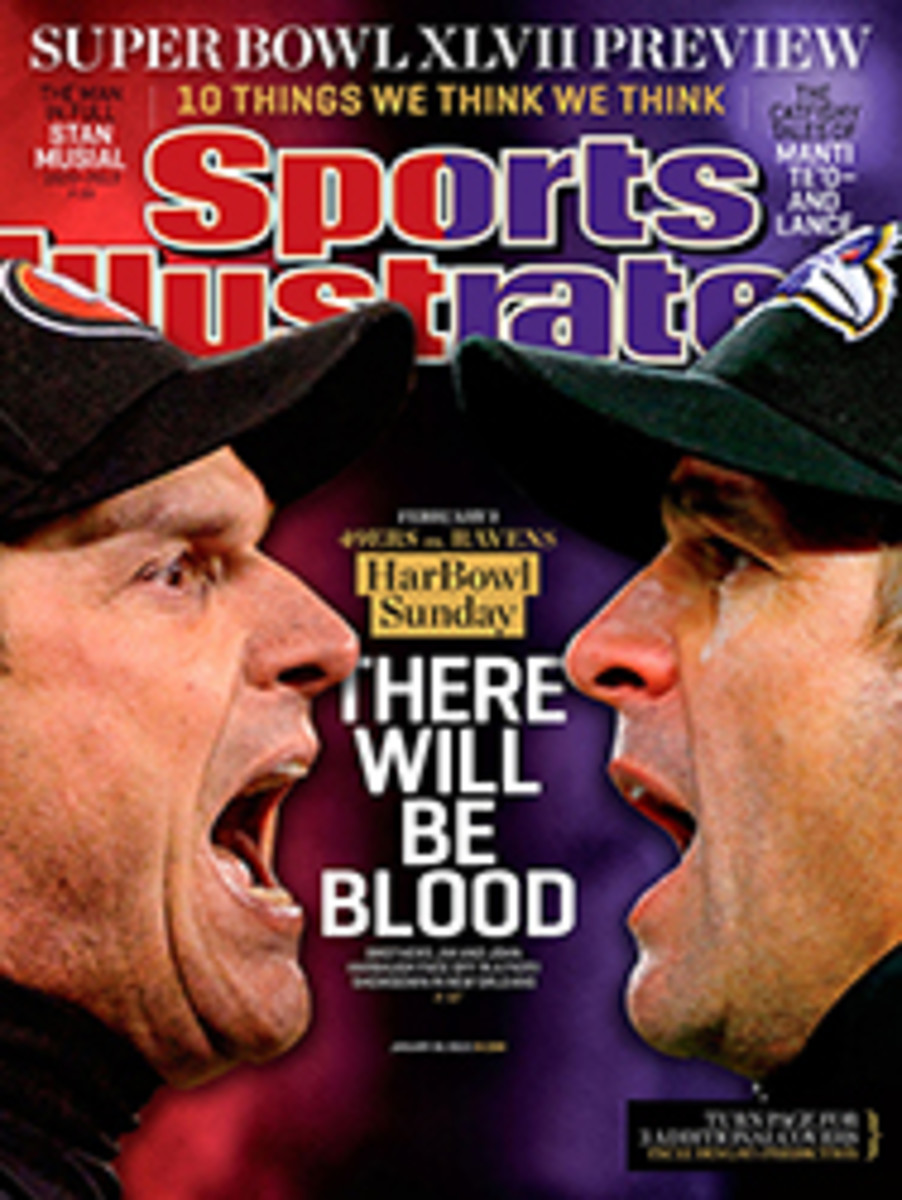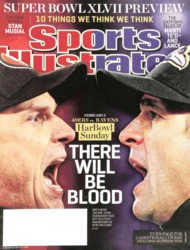
Stan Musial 1920--2013
Of baseball's postwar superstars—what a fleet of outfielders!—only Musial had a man's name. There was Mickey, Willie, even Teddy Ballgame. But Stan. That was already so grown up that his rhyming handle—Stan the Man, as he came to be known—seemed slightly redundant. He was thoroughly adult, always the mature one, the responsible one. Mantle or Mays might hit 50 or more home runs, and Williams might crash-land a jet and hit .400. All his peers would, in one category or another, eclipse him, leave him in their glittery dust, each of them more famous for their feats (or perhaps only the accident of their geography), more exciting for their flaws, more dramatic for their disappointments. But Musial would simply endure, season after season, the sheer consistency of his achievements all he'd need to ensure his legacy.
That said, it was a shock to take full measure of that consistency, upon his death last week at the age of 92. That workaday manner, untroubled by any obligations of stardom, might have unjustly dulled our opinion of him after all this time. Musial, who played all 22 of his seasons in St. Louis, was, of course, regionally adjusted when it came to the fame department; had he played at the Polo Grounds, at Yankee Stadium or even Fenway, he certainly would have been better or differently remembered than he has been. Or if, as Mantle had, he'd courted disaster as hard as spectacle—if drunken escapades could be held in tragic contrast to his tape measure home runs—he'd be considered in more heroic terms. Or, at least if he'd affected the prickliness of Williams, he might have seemed suitably complicated, driven and tortured, his life requiring yet more examination.
Instead, we have a man who was unfailingly loyal to his organization (he remained associated with the Cardinals up to his death), his wife, Lillian (to whom he was married for nearly 72 years before her death last year), and most especially to his craft. Did we mention consistency? A lifetime .331 hitter (including a few subpar years in his 40s), Musial had a 16-season run of .300-plus performances, a seven-season stretch of .330-plus. And while you don't tend to think of him as a home run hitter in the category of Mantle or Mays, he did smack 475 of them. He was, sadly for the purposes of biography, both too competent and too reliably happy for his own good. It is not the style of our age to appreciate such unironic achievement. It hasn't been since Eisenhower left office.
Yet if Musial seems from another time, in a way that Mantle or Mays or Williams do not, it is important to remember that at least during that time he was well appreciated. He may not have had the cachet of his peers, but he commanded every bit as much respect. Perhaps that hasn't translated as well as their angst, generation to generation, but for all the years he played, he was the most feared hitter in the game.
"Throw him four wide ones," was Preacher Roe's advice, "and pick him off first." Musial was simply automatic, uncoiling out of that strange lefthanded stance, hitting prodigiously and with power. "Throw it under the plate," suggested Leo Durocher.
Musial's hitting was actually an unexpected development, as the Pennsylvania native was originally groomed as a pitcher. But after hurting his arm and turning to offense, he was a nearly immediate sensation. His rookie year with the Cards he hit .315 and helped them to the first of three World Series in the 1940s.
His feats, even if they did not include such easily framed milestones as a home run title (39, the most he ever had in a season, one rained-out dinger short of tying for the league lead) or a .400 season, were plainly sufficient to the moment. He bracketed a year of military service in 1945 (he played baseball for the Navy) with seasons of .347 and .365; and his best season came in 1948, when he hit .376, homered those 39 times and drove in 131 runs, while also leading the league in runs (135), hits (230), doubles (46), triples (18), total bases (429) and slugging percentage (.702). And, while he may have been doing all this far from the media centers of the nation, it wasn't as if he were operating in secrecy. From 1946 to 1955 it was Life magazine's opinion that Musial was the best baseball player of that postwar decade.
And whatever the required characteristics of a Midwestern hero—it sometimes seemed that Musial hadn't simply come to St. Louis but that Norman Rockwell had painted him there—they did not necessarily include low recognition or low wages. Before the 1958 season, as befits an era that rewarded good work over charisma, Musial was awarded his league's first $100,000-plus salary, this after his seventh National League batting crown.
Those Midwestern values were plainly no stretch for Musial. (Allegiances to team and city were as easy for him as those to his family.) He might have been born in Donora, but he was born to play in a place like St. Louis. Perhaps you can imagine him in pinstripes, but can you imagine him in the Copa? No, he was in the right place, at the right time.
Even Musial seemed to get this, almost wink at it. Once asked the secret of his baseball longevity, he seemed to poke a little fun at his own stolid image. "Get eight hours of sleep regularly. Keep your weight down, run a mile a day. If you must smoke, try light cigars. They cut down on inhaling." Was it really as boring, as traditional as that? Oh, he added, "make it a point to bat .300."
Perhaps he understood better than us that rare talent such as his is best cloaked in humility and constancy, that his outrageous accomplishment is most easily covered by Midwestern decency. Not to deflect attention, which he enjoyed. Just to reduce its glare, somewhat. Otherwise normalcy would just be impossible.
Retirement was a long time coming for Musial, as the usual signs confounded him. At the age of 37 he was turning in a .337 season; three subsequent years of .255, .275 and .288 might have had him leaning toward retirement, but then, in 1962 at the age of 41, he hit a remarkable .330. What was he to think? Well, the next year, when he hit .255, the last hit a whizzer past a rookie named Pete Rose (time flies, huh?), he did indeed decide that it was over.
Just as he'd been an effortless ambassador as a player all those seasons, so did he prove a born envoy in his retirement. In 1967 he was lured into the front office as general manager, a situation sweetened by the partnership with manager Red Schoendienst, his roomie all those years ago. The organization required no tinkering, just patience that year, and Musial enjoyed the ride as the Cards won another World Series. He quickly retired from that executive position, as if further tinkering might require a fatal compromise of his good manners.
Instead, he spent years in ceremonial positions, preferring to devote time to his family and his restaurant. Still he remained a constant figure, his natural buoyancy a welcome comfort in the cycling fortunes of the franchise. Stan the Man was always there, it seemed, spreading his easy cheer, ready to whip out his harmonica, dispense a platitude or, if it came to that, tell a joke.
Those years were kind to Musial, even as he started to seem a lesser light among that postwar fleet. He was only the fourth player in history to make the Hall of Fame on the first ballot, so there was that. But also St. Louis, which had been so lucky to have such a devoted icon, someone who figured so prominently in such a glorious era, and who remained willing to bridge the gap to later generations, has tried to repay its baseball figurehead. They've given him two statues, the first engraved with former commissioner Ford Frick's words, "Here stands baseball's perfect warrior. Here stands baseball's perfect knight," uttered on the occasion of Musial's final game, in 1963.
In all the years since, Musial never did anything that would suggest an edit was required, careful to preserve and curate that legend of decency, of hard work and of lots and lots of hits. No engraver has ever stood at the ready to alter those words upon scandal or reconsideration. A city, maybe even the game, appreciates whatever effort that might have taken. In Musial's case, of course, probably very little.
In Musial we had a man who was unfailingly loyal to his organization, to his wife and most especially to his craft.
SI.COM
After his playing days ended, Musial remained a prominent figure in the Cardinals' organization: here in spring training 1972, the Man, then team vice president, helped straighten out St. Louis third baseman Joe Torre. For more on Musial's career, including the Man by the numbers and an appreciation by Ben Reiter, go to si.com/mag
PHOTO
BOB GOMEL/TIME LIFE PICTURES/GETTY IMAGES
PHOTO
AP
CARDINAL VIRTUE "Baseball's Perfect Knight," Musial (with Lillian, top left; in full swing in 1957, lower left; and with his final Redbirds squad, circled near left) spent his entire career in St. Louis, playing with brilliance and boundless good will for 22 seasons before hanging up his uniform in 1963.
PHOTO
STEVE SCHAPIRO/BLACKSTAR
[See caption above]
PHOTO
RICH CLARKSON
[See caption above]
PHOTO
HARRY HARRIS/AP
[See caption above]
PHOTO
ROBERT RIGER/GETTY IMAGES
[See caption above]

